Hampi – Erstwhile Capital of the Vijayanagara Empire, temples, monuments, ruins and hippie island
Ever since the devastating earthquake caused destruction to the heritage sites in Kathmandu in 2015, I had made up my mind to visit the UNESCO Heritage city of Hampi – famous for its temples and ruins.
In 2016, I decided to visit the capital city of the erstwhile Vijayanagara Empire – Hampi. Thanks to Go Heritage Run who organize runs in heritage cities, I was able to visit Hampi and many more. There is a saying in Kannada that if you want to see Hampi, you should see it by foot. I have been going to Hampi for 5 consecutive years now and covering heritage sites by different modes of transport i.e. cycling, running and with my personal vehicle.
How should I describe Hampi?
Located about 20 kms from the city of Hospet, Hampi is a large area which is sadly completely in ruins. If you appreciate history and have an interest in mythology, Hampi is a must visit for its monuments, temples and ruins!
The terrain of Hampi is bouldery all around and very different from any other city you would have visited. The stone chariot of the Vittala temple is the most featured highlight when it comes to Hampi. The Virupaksha temple is the only functioning temple till date and a sprawling complex.
The Tungabhadra River passes through Hampi and is an importance water source even today. The great poet Purandaradasa used to recite poems beside the banks of the Tungabhadra river!
For wildlife lovers, there is a large sloth bear sanctuary (Daroji Bear Sanctuary) spread across about 6000 hectares. There is also ‘Atal Bihari Vajpayee Zoological Park’ in Kamalapura which was opened recently in 2017.
Lastly the Tungabhadra dam not far away in Hospet is worth a visit either on your way to or back from Hampi.
The Mighty Vijayanagara Empire
The Vijayanagara empire at one time ruled most of Southern India and spanned across 3 centuries (1336-1646). It was established by the two brothers Harihara I and Bukka Raya I of the Sangama dynasty. Many a dynasties such as Sangama, Saluva, Tuluva and Araveedu ruled the Vijayanagara Empire. Krishnadevaraya’s rule of the Vijayanagara Empire were considered to be the golden years where he won many a wars against the Deccan Sultanates.
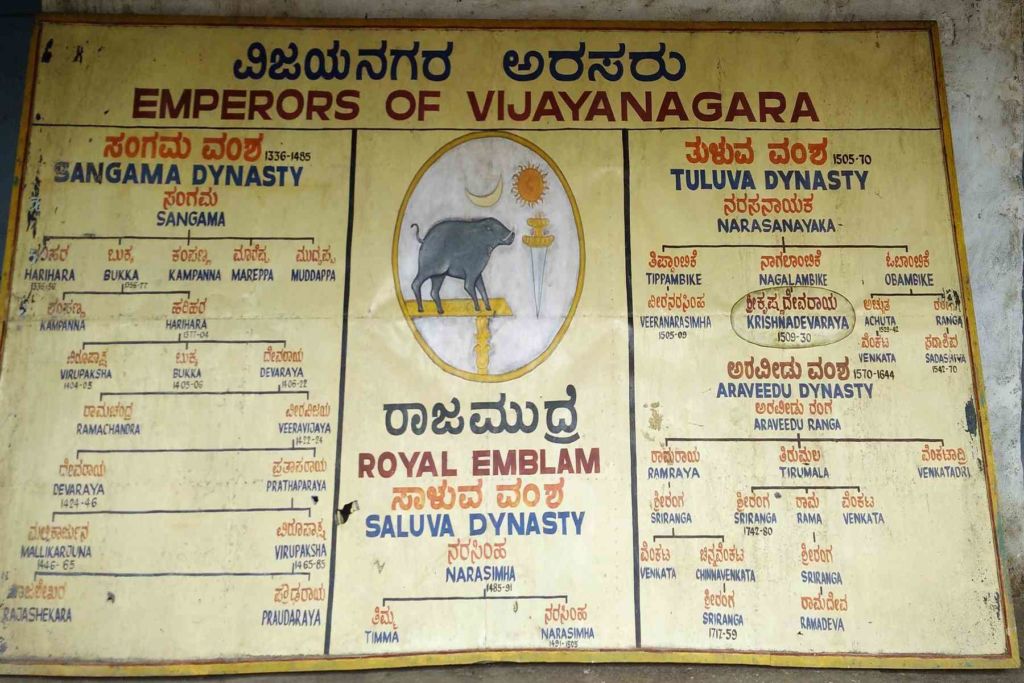
Krishnadevaraya – The Greatest King of the Vijayanagara Empire
Krishnadevaraya from the Tuluva dynasty was one of the most popular kings to rule the Vijayanagara Empire and to take it to great heights; the best times being 1509-1529. Krishnadevaraya was a great administrator who kept all forces at bay mainly the Bahamani’s who fought many a battle against him. As a king, he led from the front and also battled against the Gajapatis of Orissa.
Krishnadevaraya respected all religions and was regarded as a perfect king. This is documented by the historians who visited Hampi who saw it prosper under his rule. Krishnadevaraya engaged with the Portuguese and Chinese in trade which is depicted in many of the ruins. He also set up water conservation ecosystem which is at display even today at the Mahanavami Dibba.
Successors post Krishnadevaraya
Krishnadevaraya died due to sickness in 1529 and was succeeded by his brother Achyuta Deva Raya who ruled until 1542. His son Venkata ruled briefly before Krishnadevaraya’s son-in-law ‘Aliya Rama Raya’ pronounced himself as the King as Venkata’s nephew ‘Sadasiva Raya’ was still young. When Sadasiva Raya grew of age, Aliya Rama Raya imprisoned him and continued to rule the empire.
In the battle of Talikota in 1565, the Deccan Sultanates all got together and attacked Aliya Rama Raya. Aliya Rama Raya’s capture and subsequent beheading led to the decline of the Vijayanagara Empire and the plundering of Hampi reducing it to rubble.
Tenali Rama
Tenali Rama or Ramakrishna was a very clever poet and advisor to Krishnadevaraya. He was very witty and solved many a problems for the King during his rule. The stories of Tenali Rama are very popular and the TV series off course!
Heritage sites and ruins around Hampi:
Following are some of the many heritage sites (85 in total) I visited in my visits to Hampi…
Hemakuta Hill:
Hemakuta Hill is located very close to the Virupaksha temple. I felt the climb to the top of the hill to be fairy easy with its gentle slopes. There are many temples and structures on this hill and one gets a good view of the Virupaksha temple from here. This is also a great place to see the sunrise or sunset in addition to Matanga Hill which is covered in the next section.
Mythological connect:
As per the legend, Lord Shiva performed a penance at Hemakuta Hill after his consort ‘Sati’ embraced death by entering the fire. Sati did so as she was insulted by her father Daksha as he showed scant respect for Shiva. His penance was however disturbed by Kama (God of Lust). This act of Kama enraged Shiva who opened his third eye and reduced him to ashes.
Why did Kama break the penance of Shiva?
Kama was advised by the Gods to break the penance of Shiva as only his offspring could kill the demon Tarakasura. By breaking the penance, Kama drove Shiva’s attention to Pampa (another name of Goddess Parvathi) who was offering penance to him at Pampa Sarovar. Impressed with her devotion Shiva falls in love and marries her. A son (Karthikeya) is born to them who goes onto kill Tarakasura.
Read more about the place where Pampa offered penance in the Pampa Sarovar section.
Read more about King Daksha who was killed by Veerabhadra in the Uddana Veerabhadra section.

Matanga Hill:
I had just completed my first (half marathon) heritage run in Hampi, when we decided to climb up the Matanga Hill. Not being an active trekker and someone who is scared of heights, it took me about 30 minutes to scale up the hill.
I must admit there is no better to get a 360 degree view of Hampi than from Matanga Hill.
From the top, one can envisage how the Vijayanagara Empire looked many a centuries back. The Tungabhadra River, Hampi Bazaar, Achyutaraya temple and many other monuments are visible from here. There is a small temple dedicated to Lord Veerabhadra in a dilapidated condition at the top. If you look carefully enough, you can see carvings of Veerabhadra and other gods on the rocks.
It was difficult trek for me coming down as I was in my flip flops! I therefore recommend to wear comfortable shoes and climb Matanga hill early in the morning. By doing so one can catch up with the magnificent sunrise and also avoid the heat.

Achyutaraya Temple:
The Achyutaraya temple earlier known as Tiruvengalanatha (Vishnu) temple was built under the rule of King Achyutaraya. Achyutaraya was the younger brother of the great King Krishnadevaraya. This temple is best approached by climbing the steps behind the monolithic Nandi. As per the epigraph, this temple was built by Achyutaraya’s brother-in-law and chief minister ‘Hiriya Tirumala’. This temple was the last of the temples built before the downfall of Hampi. The exquisite pillars of this temple complex have some wonderful carvings of Lord Vishnu and Krishna.
Because of the secluded location, this grand temple is not frequented by tourists. A pair of rectangular enclosures surround the main shrine of the the temple. The pillared walkways of the inner walkway are in a better condition when compared to the outer. One gets a fantastic view of the temple from atop Matanga hill.
In front of temple is the Courtesan Street (Sule Bazaar) which merchants used to sell stocked up precious stones and pearls! The early travelers described this pearl bazaar as one that never existed anywhere in the world! Sule Bazaar in local language means Prostitute’s market. No idea why this bazaar that sold pearls was called by this name.
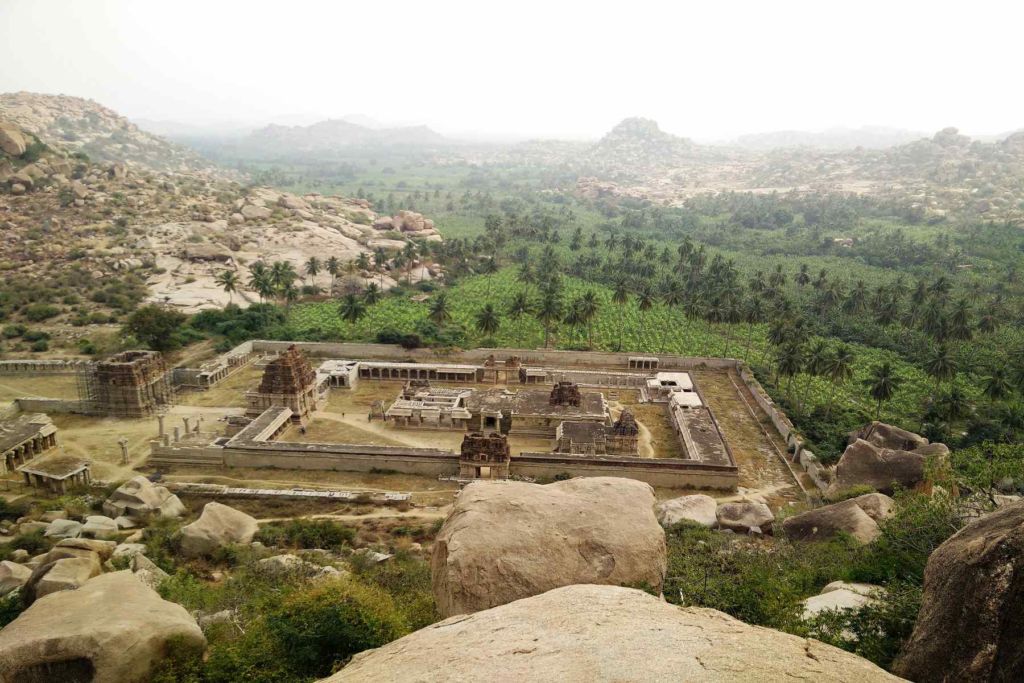
Hampi Bazaar:
The Hampi Bazaar is located close to a parking area near the Virupaksha temple. As you walk towards the Monolithic Nandi or the Virupaksha temple, you can see the dilapidated pillars of the Hampi Bazaar on either side. During the golden period, the bazaar catered to local and imported goods for both the riches and masses.
It is said pearls and precious stones were sold on the street side shops in Hampi Bazaar during the golden Vijayanagara period! What remains of the bazaar today is nothing apart from pillars and in some cases two storeyed complex resting on pillars.
Bazaars were located in front of temples, therefore you will see them which in front of Krishna temple and Vittala temple. It is said that the bazaar located in front of Krishna temple was a trading area for diamonds and gems!
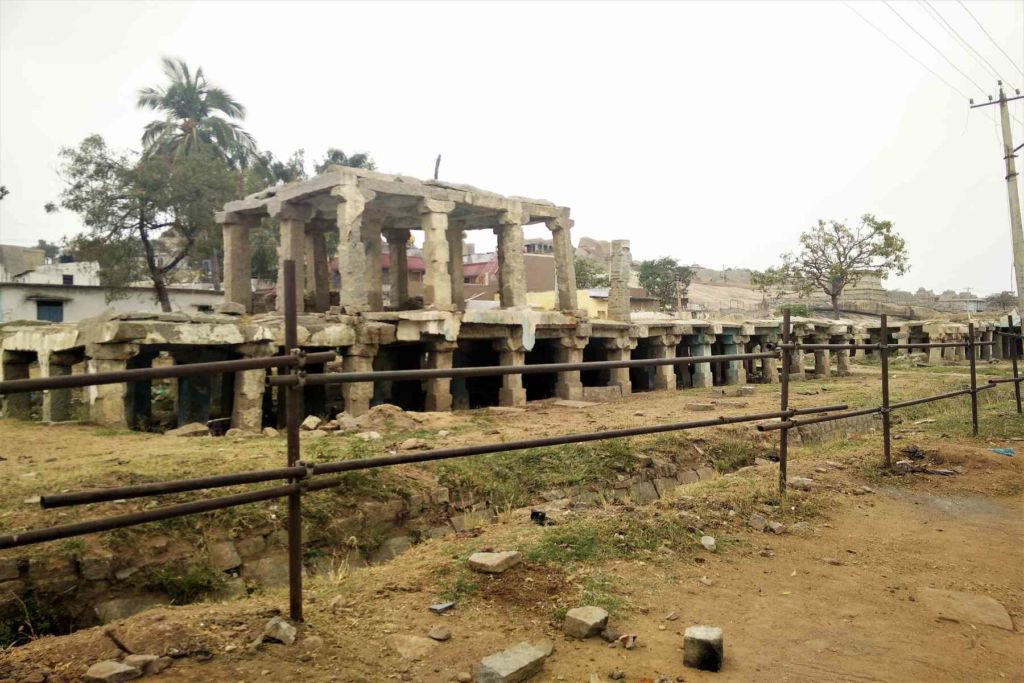
Monolithic Nandi:
One end of the Hampi Bazaar leads to a large monolithic statue of Nandi. Like all Shiva temples, this large size bull sits facing the Virupaksha temple which is at a distance of approx. 1 km. The boulders in the backdrop provides an interesting view of the Nandi seated in a pavilion. Some parts of the bull are mutilated and thus not worshiped. The steps behind the Monolithic Nandi lead to the grand Achyutaraya temple on the east and Matanga hill on the west.
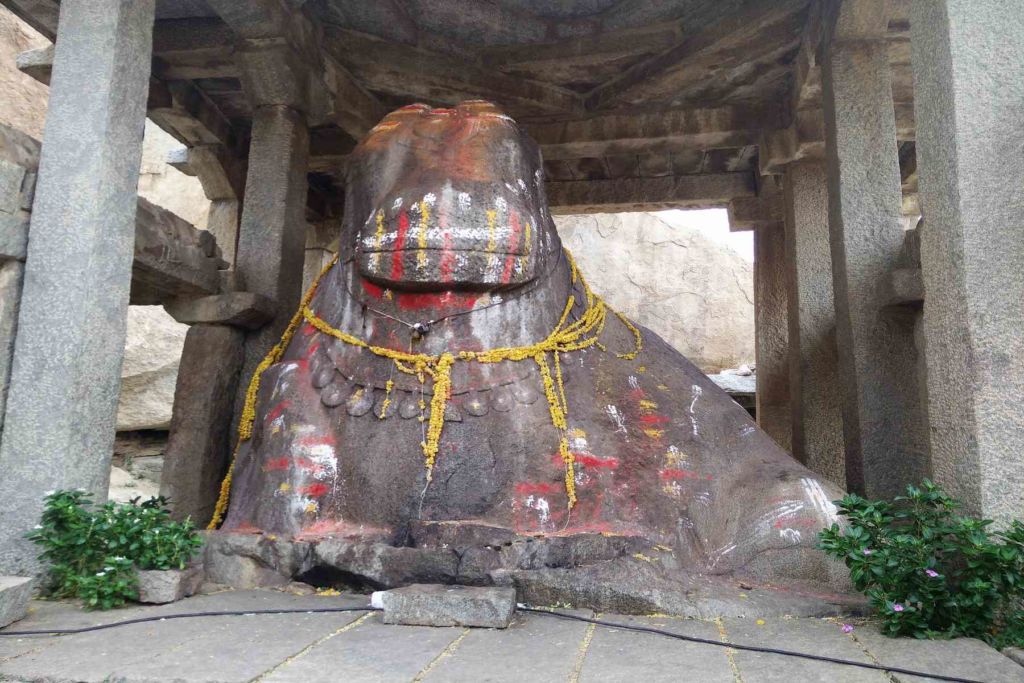
Virupaksha Temple:
This is the only functioning temple in Hampi along with a few others. This temple dedicated to Lord Shiva has a large tower spread across a massive area with impressive sculptures. Built during the 7th century by the Badami Chalukyas, this temple has mysteriously survived the destruction by the Deccan Sultanate.
This temple started as a shrine has had its contributions from the Chalukyas, Hoysalas, and then the Vijayanagara Empire. I was surprised to see a 3 headed Nandi statue on entering the temple, one of the heads is damaged though.
It is here you will see many people trying to put their palms across a semicircular stone. If the fingers of both palms meet, it is considered to be lucky. I did see see a lot of monkeys in the temple however they were fairly innocuous.
One of the highlights of this temple is the inverse image of the Raja gopuram on the wall through a small opening. It did remind me of the pinhole camera effect where the image inverses as light passes through a small opening. Such was the thought process many a centuries back – pretty amazing would you not agree?
How did this temple survive the plundering of Hampi?
It is indeed surprising how this temple with a large size gopuram escaped destruction. The reason being the large gopuram was constructed in the 17th century (after Hampi was reduced to rubble) by Bishtappaiah, a follower of sage Vidyaranya. Bishtappaiah also was instrumental in the resurrection of the temple and its surroundings. This Raja gopuram has since been known as Bishtappaiah gopuram however there is no indication in written form.
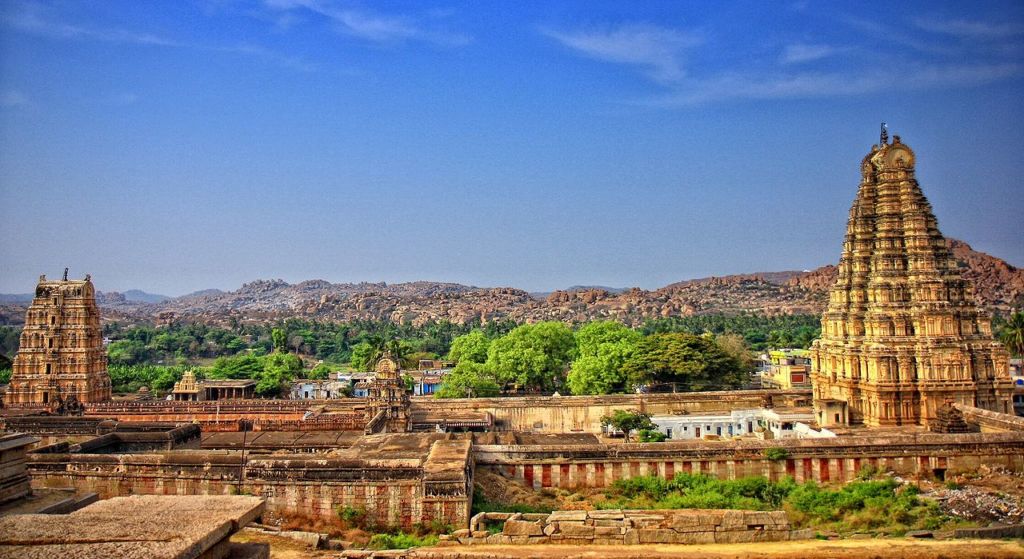
Sasivekalu Ganesha:
Not far away from Virupaksha temple is is the 8 feet monolithic statue of Sasivekalu Ganesha. The belly of the Ganesha idol is in the form of a Mustard Seed and therefore called Sasivekalu (mustard seed in Kannada) Ganesha. The snake around the stomach of Ganesha is quite prominent. As per the legend, Ganesha tied the snake around his belly to prevent it from bursting due to excessive eating! The trunk of the idol is damaged and hence not worshiped anymore.
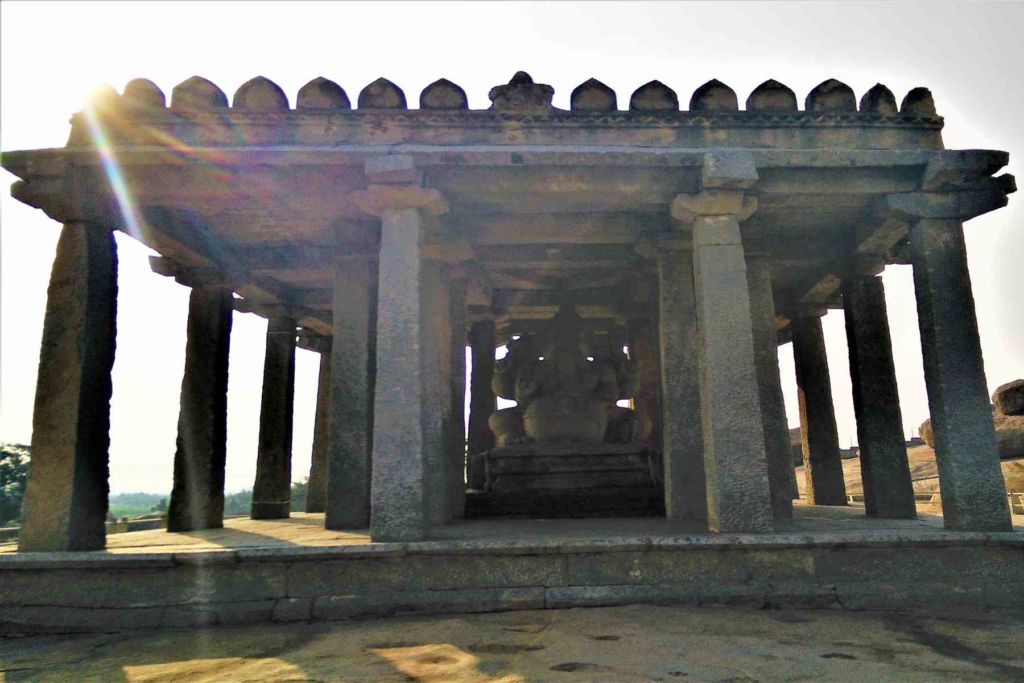
Kadalekalu Ganesha:
Located close to Sasivekalu Ganesha is the 15 feet monolithic statue of Kadalekalu Ganesha. The belly of Ganesha is in the form of a Bengal Gram and hence named Kadalekalu (Bengal Gram in Kannada) Ganesha. The trunk and belly of Ganesha is damaged and hence not worshiped. This temple has large sized pillars leading to the Ganesha idol. From the platform of the temple, one can get a view of Virupaksha temple.
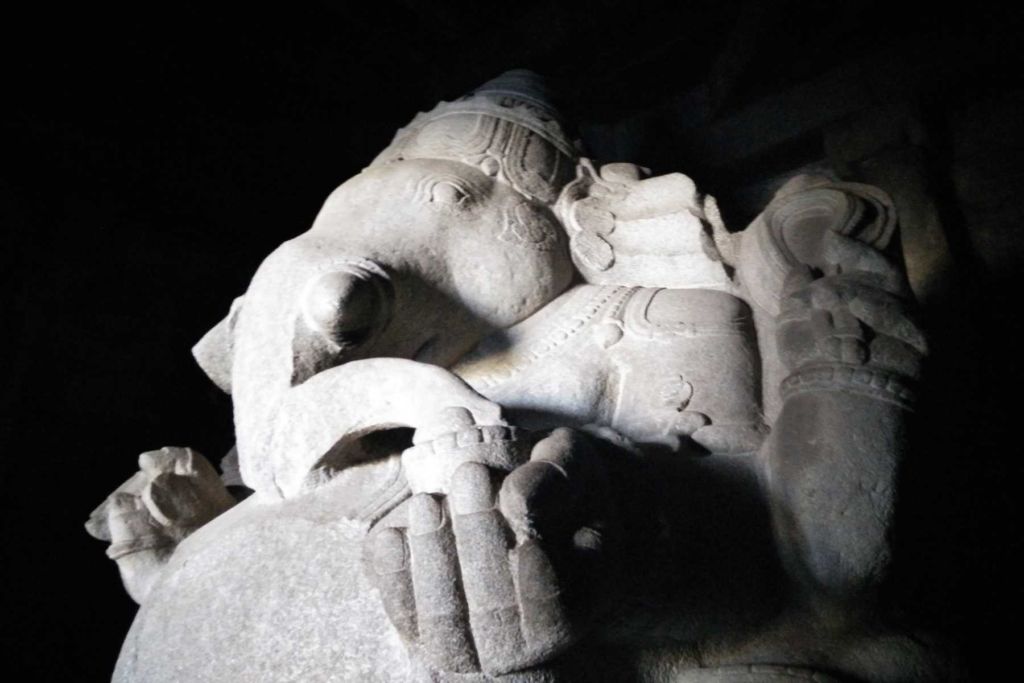
Krishna Temple:
This massive temple of infant Krishna has impressive carvings and certainly not to be missed. Undergoing restoration by ASI, this temple has stories of Krishna depicted on its towers. Opposite the temple is the large Krishna Bazaar which once dealt in diamonds and gems. There is a kalyani (pond) where the Krishna bazaar is located.
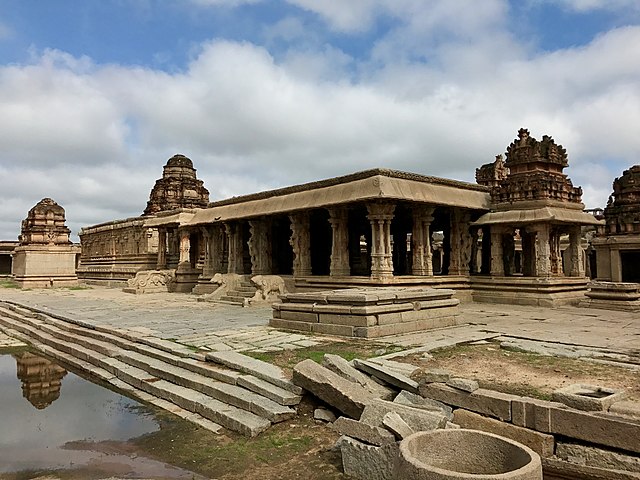
Chandikesvara Temple:
This temple is located just before the Uddana Veerabhadra temple around the corner. This Vishnu temple has many intricate carvings on its pillars with carvings of little Krishna, Hanuman, Vamana, Yalis and Vyalas. There are no idols in the temple and hence not worshiped anymore.

Uddana Veerabhadra Temple:
The Uddana Veerabhadra (an incarnation of Lord Shiva) temple is a functioning temple in Hampi. The Veerabhadra statue here stands 16 feet tall and is the tallest image in Hampi. Built during the 15th century, the idol has been growing by a centimetre every year and reached the ceiling of the temple! Beside the idol of Veerabhadra in warrior form is the idol of Daksha with a goat head.
Who is Daksha and why does he have a head of a goat?
King Daksha was responsible for the death of his daughter Sati, who also was the spouse of Lord Shiva. This enraged Lord Shiva who thrashed his hair lock resulting in the birth of the mighty Veerabhadra and powerful Bhadrakali. Shiva advises Veerabhadra to destroy Daksha and his army. Veerabhadra promptly destroys the army and severs the head of Daksha. However at the request of Daksha’s wife and other Gods, Shiva is forced to revive Daksha but by planting a goat’s head. Thus you see the idol of Daksha with a goat’s head here and beside the statue of Veerabhadra.
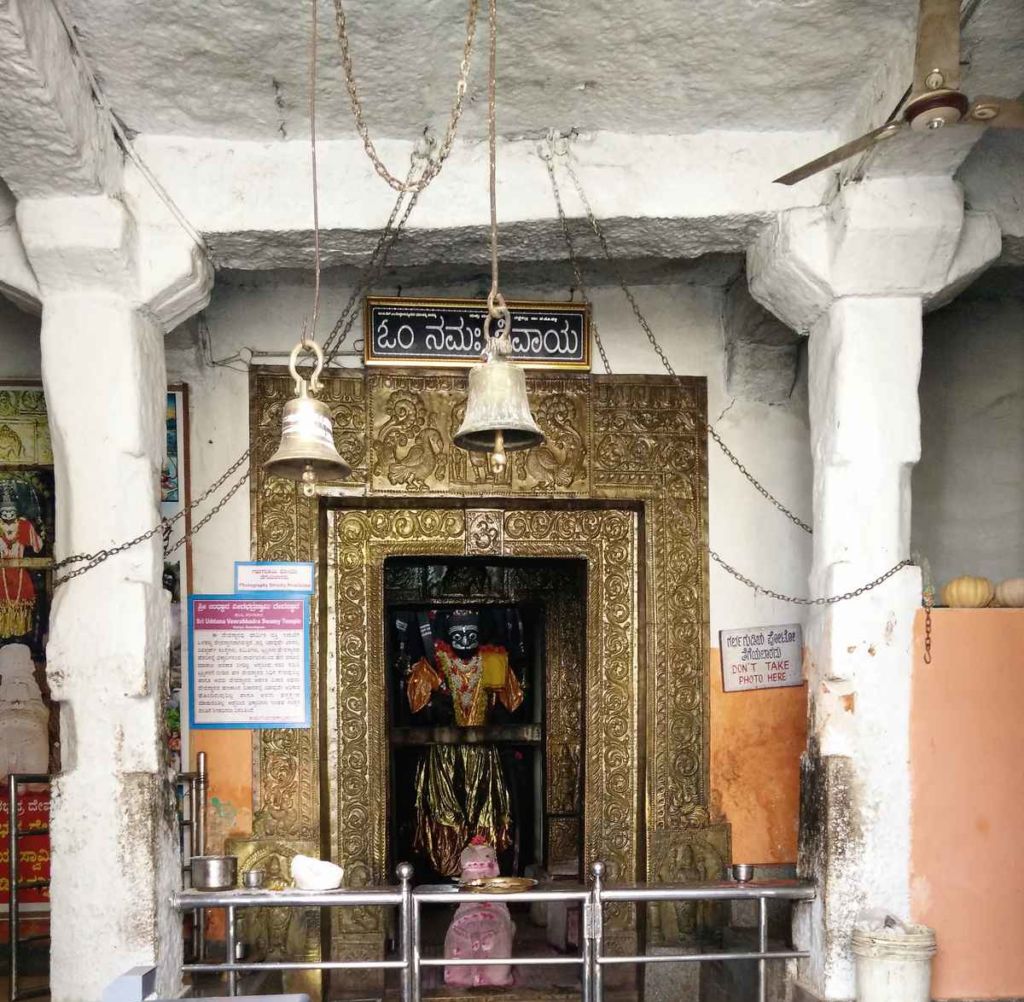
Ugra Narasimha statue:
As one passes the Veerabhadra temple and the banana plantations, one sees a huge statue about 22 feet in height of Ugra (angry) Narasimha. Narasimha is an avatar of Lord Vishnu in half human and half lion form who goes on to kill the demon Hiranyakashipu. Its quite sad to see the hands and feet of the statue chopped as a result of the destruction. Very close to this statue is the Badavilinga temple.
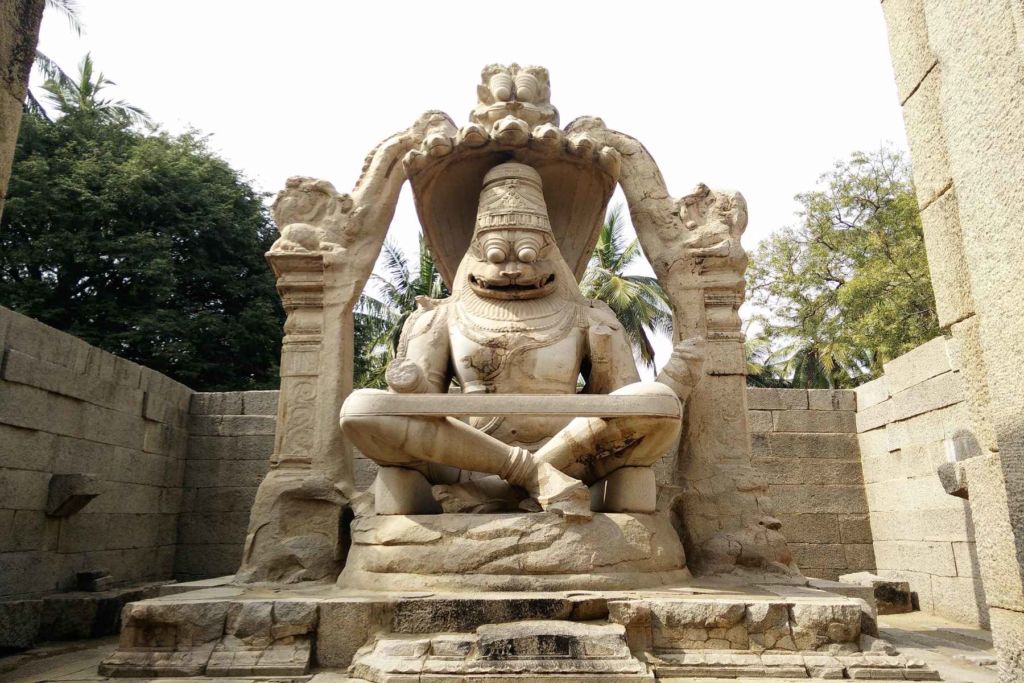
Badavilinga Temple:
Located close to the Ugra Narasimha statue is Badavilinga temple. This temple has a large linga with water below. This is supposed to be commissioned by a poor woman hence the name Badavilinga.

Underground Shiva Temple:
Strangely built a few meters below the ground level, this Underground Shiva temple is one of the oldest temples in Hampi. Most of the times This 14th century Shiva temple discovered only recently (1980’s) bears an inscription of the grant made by Krishnadevaraya on his coronation in 1513.
I have visited this temple, there is always a presence of water at the sanctum. A beautiful and well maintained lawn surrounding the temple serves as a perfect place to rest.
There are a few theories as to why the temple remains underwater for most of the year, they being:
- Water from the Tungabhadra flows into the temple
- During the monsoon the water released from the dam floods the temple
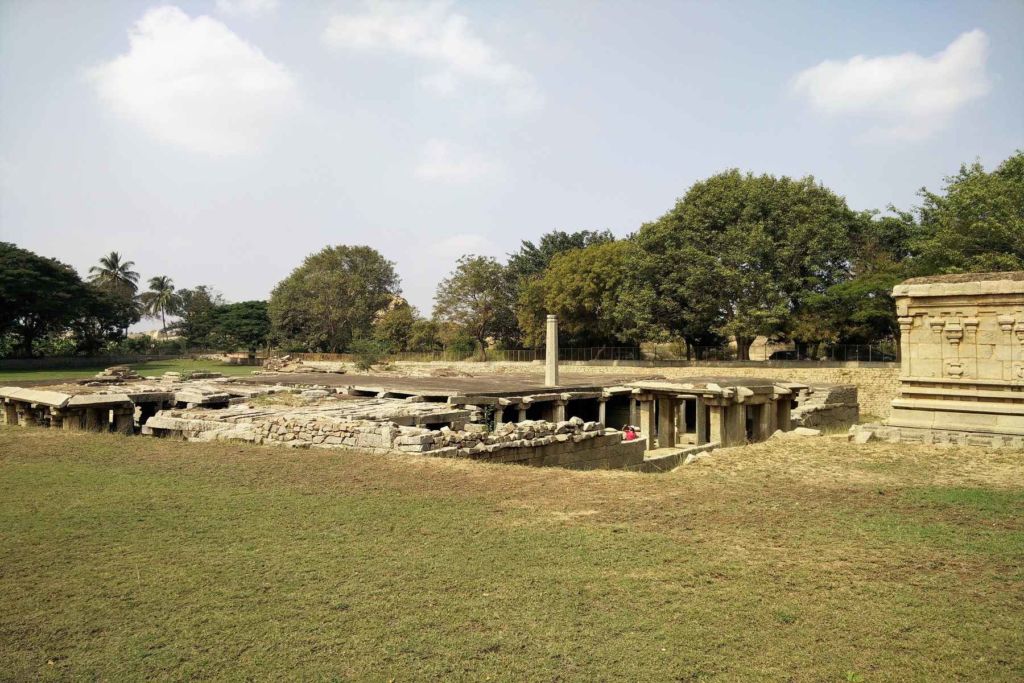
Nobleman’s Quarters:
Not far from the Underground Shiva temple are the remains of stone based palatial structures. Basis the plan and design of the layout, it is believed that people from the royal court of Krishnadevaraya stayed here.
Because of which this area is called as Nobleman Quarters which was razed to the ground by the Deccan Sultanate. Most of the houses appear rectangular in shape and separated by a common wall. One gets a great view of the Nobleman’s Quarters by either climbing a tall rock or from the Mohammadan Watch Tower not very close by.

Hazara Rama Temple:
Located in the midst of the Royal enclosure is the 15th century Hazara Rama Temple. Dedicated to Lord Rama – an avatar of Lord Vishnu, this was a private temple for the King and his royal family. The temple is famous for the many sculptures of the epic Ramayana around the main shrine, Luva-Kusha story on the devi shrine and that of infant Krishna. There are also many carvings of soldiers, horses, elephants and girls on the walls in addition to the sculpted polished pillars in the main hall.
Some of the many sculptures of the epic Ramayana on the walls are:
- Lord Rama killing the monkey king Vali while fighting his brother Sugreev
- Sita giving a jewel to Hanuman to be handed over to Rama
- Sita requesting Rama to capture the golden deer (Maricha)
- Rama killing the golden deer (Maricha)
- Demon King Ravana fighting the divine bird Jatayu
There is so much to see, one can spend an hour or two basis one’s interest ! Unquestionably I have spent a lot of time here in sheer admiration of the sculptures which tell a story.

Zenana Enclosure:
The Zenana enclosure was a well guarded area reserved for the Royal women. The enclosure includes the Queens palace, Water Pavilion, Treasury Building and Lotus Mahal.
Watch Towers, Queen Palace, Water Pavilion and Royal Treasury:
This enclosure includes 3 watch towers built in Indo-Islamic style. From the top of the two storied high one gets a view of the Elephant stables situated behind the enclosure. The Queens palace is in ruins with only a 3 tiered base that exists today. Located opposite the Queens palace is the Water pavilion situated in the center of a shallow pool. The treasury building looks fairly simple in comparison with the remains of the other structures.
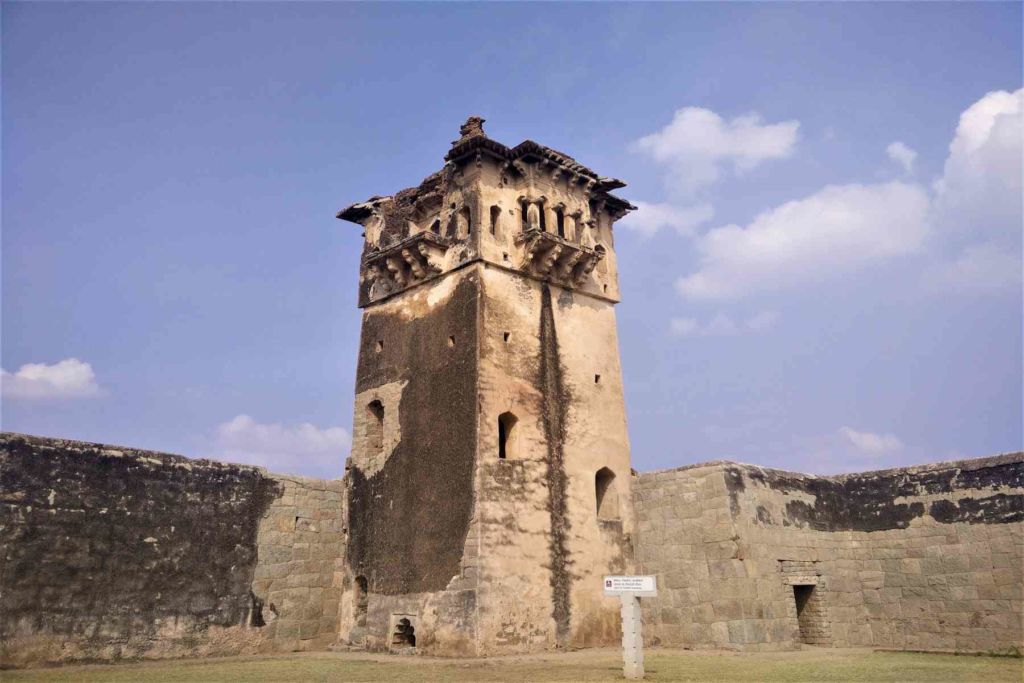
Lotus Mahal:
Built in Indo-Islamic style, the Lotus Mahal is a beautiful structure in the Zenana Enclosure. This two storied structure was used by the women of the royal family perhaps as a matter of recreation or socializing. This is one of the few structures that remained untouched when Hampi was plundered and entry is not permitted.
The Lotus Mahal got its name due to its resemblance to a half opened lotus bud. Made up of lime mortar and brick, the Lotus Mahal has an open base floor with tall arches as its sidewalls and arched windows in the upper floor.
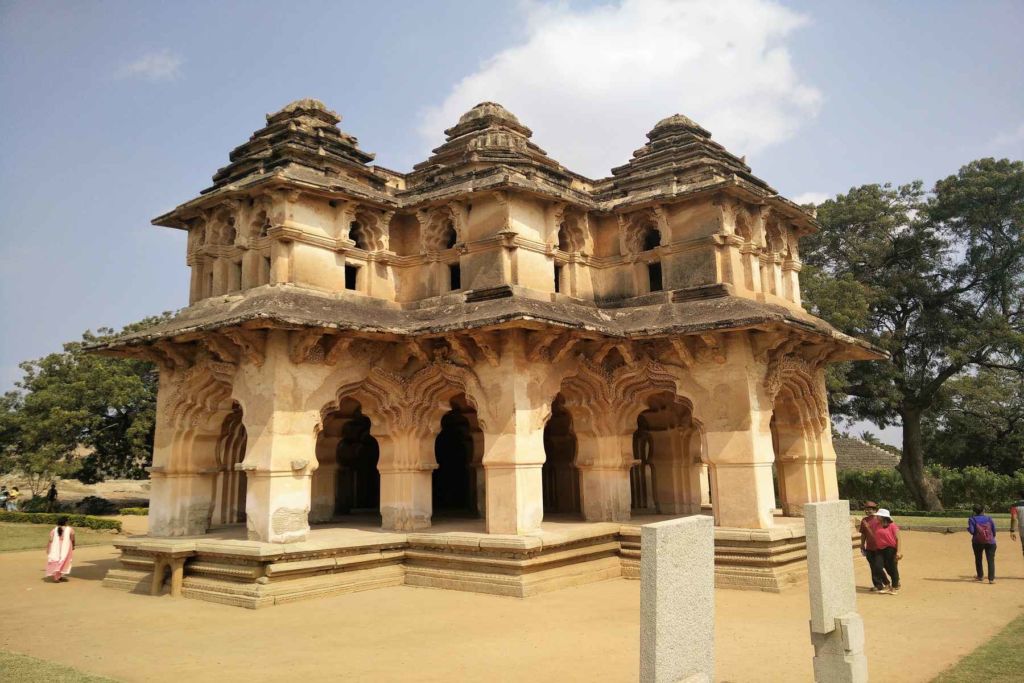
Elephant Stables:
Located close to the Royal enclosure are the Elephant Stables to house elephants. All of the domes of the elephant stables are of the same size but sport a different design. This elephant stable structure is largely in good condition. The damaged upper chamber of the central stable follows a Hindu architecture when compared to the rest of the domes that follow an Islamic style.
All the stables are interconnected and there is a presence of a hook on the roof to tie the elephants. A small opening now closed by bricks used to provide mahouts with backdoor access when the opening was closed.

Mahanavami Dibba:
Located in the Royal enclosure is a massive pedestal – the largest in Hampi standing 12 meter high. The base of the platform measures 35 meters at the top of the pedestal about 25 meters. Built by Krishnadevaraya, this pedestal is a sign of victory over Udayagiri. This platform was the viewing area for the great King Krishnadevaraya to watch the festivities, competitions in wrestling, aquatics, musical performances and navaratri celebrations.
I have always wondered how the view would have been watching the celebrations from the top. And how the King would communicate with the people standing below. There is an underground chamber a little away from the stage specifically for having secret discussions.
It is difficult for the elderly to climb to the top from the front as the stairs are steep. There exists another staircase at the back which perhaps served as a service staircase for ceremonies. There are many a carvings of horses, elephants, warriors, dancers and musicians performing. One gets a great view of the surroundings from the top.

There is a a very pretty ‘step tank’ in the royal enclosure. The architecture of this tank in the form of pyramids makes it look very beautiful. One is not permitted to descend the steps of this tank.
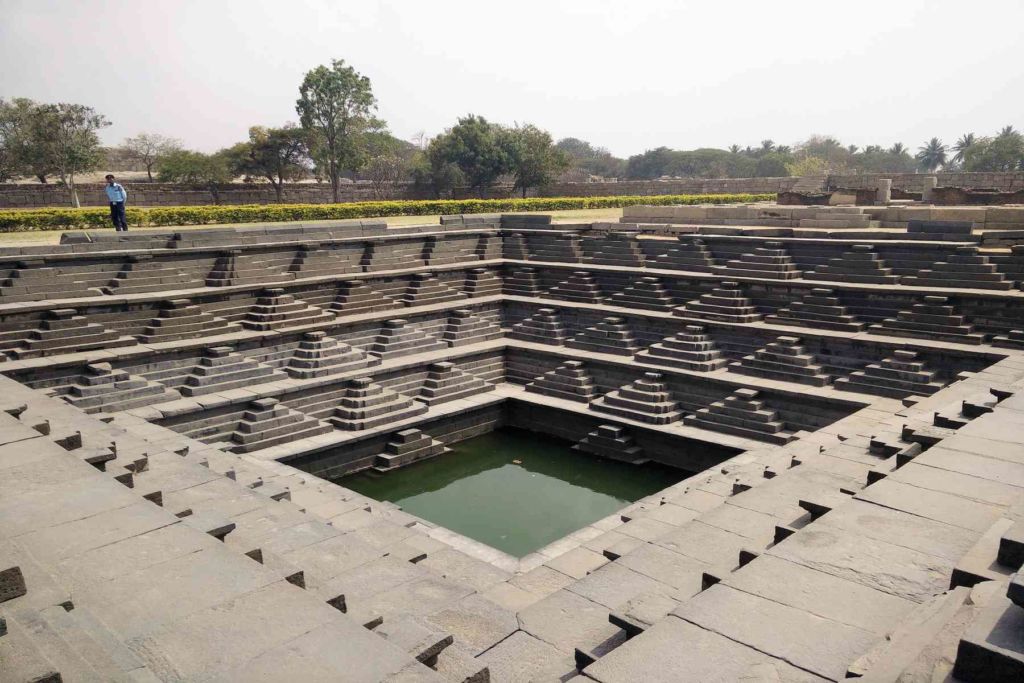
Queen’s bath:
Built in Indo-Saracenic style and not far away from the Royal Enclosure is the Queens Bath. Yes, you guessed right – it’s supposed to be the place where the Queen and her companions bathed. From the outside, it looks like a very ordinary structure surrounded by a moat thus preventing any intruder from peeping in! As you enter this area, you will see a sunken bath area which is about 6 feet deep.
This place definitely reminded me of the grand scale sets out of a Bollywood movie! There are many viewing areas (balconies) along the walkway which face the bathing area. This is a common place where photographers pose for a photo. The bathing pond is open to the sky and has no covering. There possibly was a covering basis the presence of sockets at the bottom of the pool to support some form of structure above. As you pass through the veranda, you can see many designs on the ceiling which have withered away in time. The waters from the Tungabhadra river flowed to the bathing area via the water channel.

Octagonal bath:
Close to the Queens bath and along the way to Chandrashekara and Saraswathi temples is the Octagonal bath. This is not as grand as the Queens bath and possibly could be a bath for the commoner. Unlike the Queens bath, this structure in the form of an octagon is open and supported by columns with a central platform. This structure looks fairly ignored and as a matter of fact not frequented by travelers.
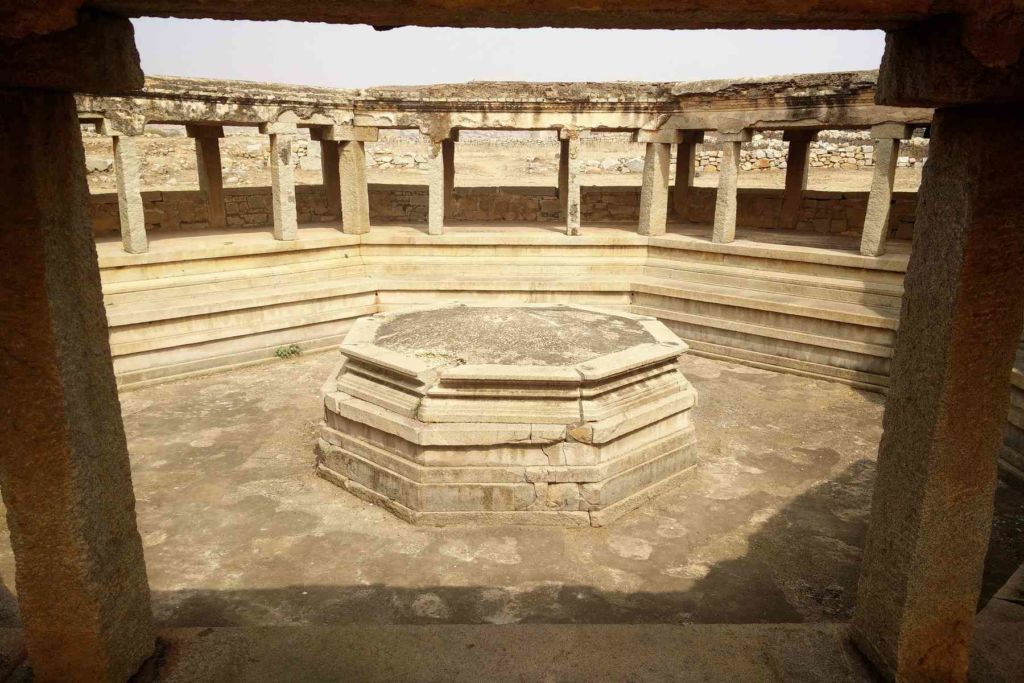
Chandrashekara Temple:
Not far away from the Octagonal bath and Queens Bath are the temples of Chandrashekara and Saraswathi. The entrance to the 16th century Chandrashekara temple is in a mutilated condition especially the stucco figures. This temple has two shrines each dedicated to Lord Shiva and his consort Goddess Parvathi. This temple is not very frequented by visitors.
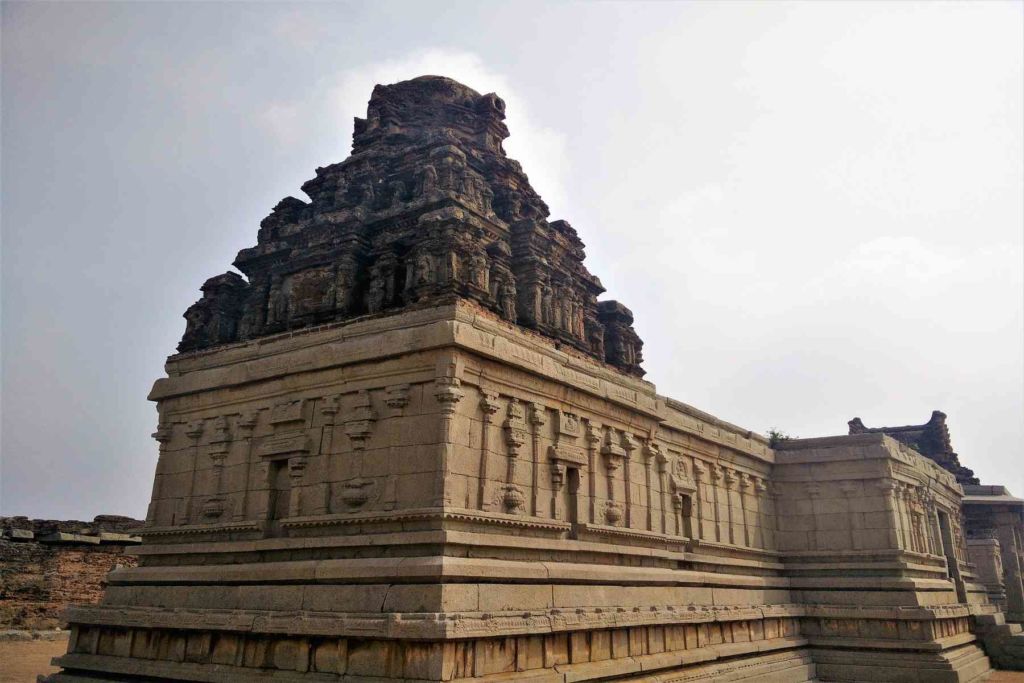
Saraswathi Temple – II:
There are two Saraswathi temples in Hampi and this one is located close to Chandrashekara temple. Like the Chandrashekara temple, this temple too has mutilated stucco figures on entrance tower. They seem to be built during the same time period. Built on top of a rock, this temple has great carvings especially of infant Krishna on its pillars. The ceiling from the sanctum area of the temple is provides some degree of light and must have been planned keeping this in mind.

Pattabhirama Temple:
Located 6 kms from Kamalapura, the Pattabhirama temple is not on the usual heritage circuit. This temple was in a suburb by the name of Varadadevi Ammana Pattana of the ancient city of Vijayanagara. As a matter of fact Varadadevi happens to be the name of the queen of King Achyutaraya!
This temple is dedicated to Lord Rama has beautiful carvings and surrounded by a rectangular wall complex. Although this temple is as large as the Vittala temple, its grandeur ranks lower in comparison. Unlike the Virupaksha and Vittala temples, this temple is comparatively less frequented by tourists. There is a large kalyani (pond) with interesting matrix of pillars on one of the sides. The Domed Gateway is the closest monument from this temple along with the ASI museum.

Domed Gateway:
Located at walking distance from the Pattabhirama temple is the Domed Gateway. This 42 feet Indo-Islamic style gateway looks particularly important basis the close proximity to the Royal enclosure. This largely intact gateway raised on top of the wall has 4 arches at the first level, then 2 smaller window type arches on the next level and finally a dome on top of it. Sadly people have written their names on this gateway and needs to be protected. This gateway certainly looks very different than Bhima’s Gateway and Talarighatta gate.
On taking a good look at the walls of this complex, I could find carvings of an elephant, Ganesha, Hanuman and an imaginary fish with a face of a lion, a trunk and legs! The intricate design on the arch leading to the complex is still fairly intact. There is guards room inside the Domed Gateway sporting an image of Hanuman. Also there is carving of a Shiva linga, Nandi and Parvathi on the wall and a large broken platform in front of it. I suspect there might have been a small temple structure considering the raised platform and a Nandi statue facing the Shiva linga. Sadly both the Nandi’s facing the image on the wall and the one on the wall have their heads chopped off. There is also what looked like a stepped fire ritual close to the platform.
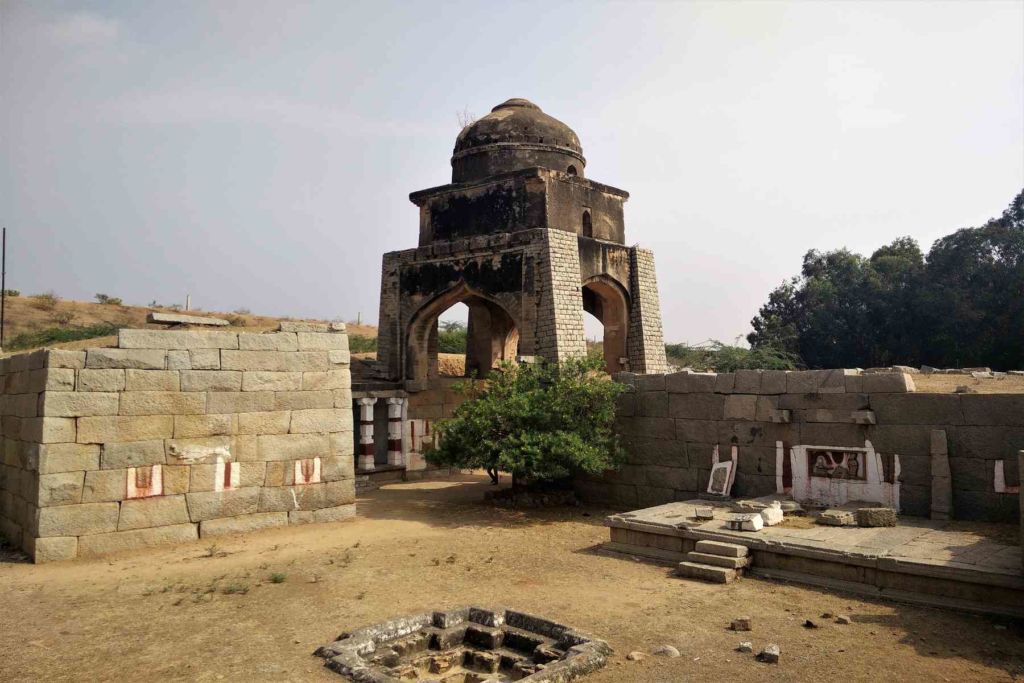
Ganigitti Jain Temple:
If you are running the 12 km or half marathon in Hampi, you shall pass both the Ganigitti Jain temple and Bhima’s gateway. The sun rising in the backdrop of the Ganagitti temple provides a great sight!
Built in the 14th century by Iruga the commander in chief of Harihara II of the Vijayanagara empire; this temple has a huge lamp column with an inscription mentioning this as Kunthunatha Jain temple. Dedicated to the 17th Thirthankara of the Jain faith – Kunthunatha, this temple has no idol within however a stucco image of the Jain saint on the parapet it.
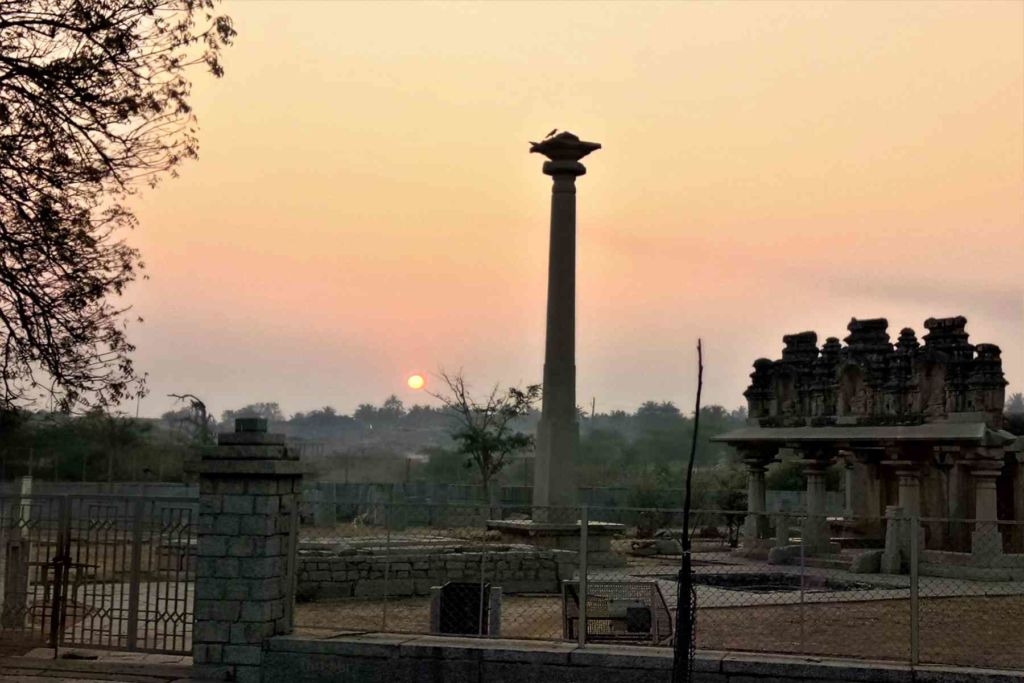
Bhīma’s Gateway:
Named after the legendary Bhima from the Mahabharata epic due to the strong defense system, this gateway is located beside the Ganagitti Jain temple. This gateway has an interesting design and construction style. One cannot enter this gateway in a straight line, there are many a turn (left and right) to pass through it. With the army positioned above, it was undoubtedly tough for the enemy to quickly pass through. Not knowing what is in store ahead after the turn, without a doubt this is a perfect blind spot!. Moreover this unique design made it difficult for elephants to make adjustments at the turns.
As per the epic Mahabharata, Bhima was the strongest of the Pandava brothers. There is an interesting sculpture of Bhima holding a mace and Saugandhika flower on a small platform placed near one of its walls. There are also carvings on the wall of Draupadi tying her hair and slaying of kichaka by Bhima for attempting to molest Draupadi.
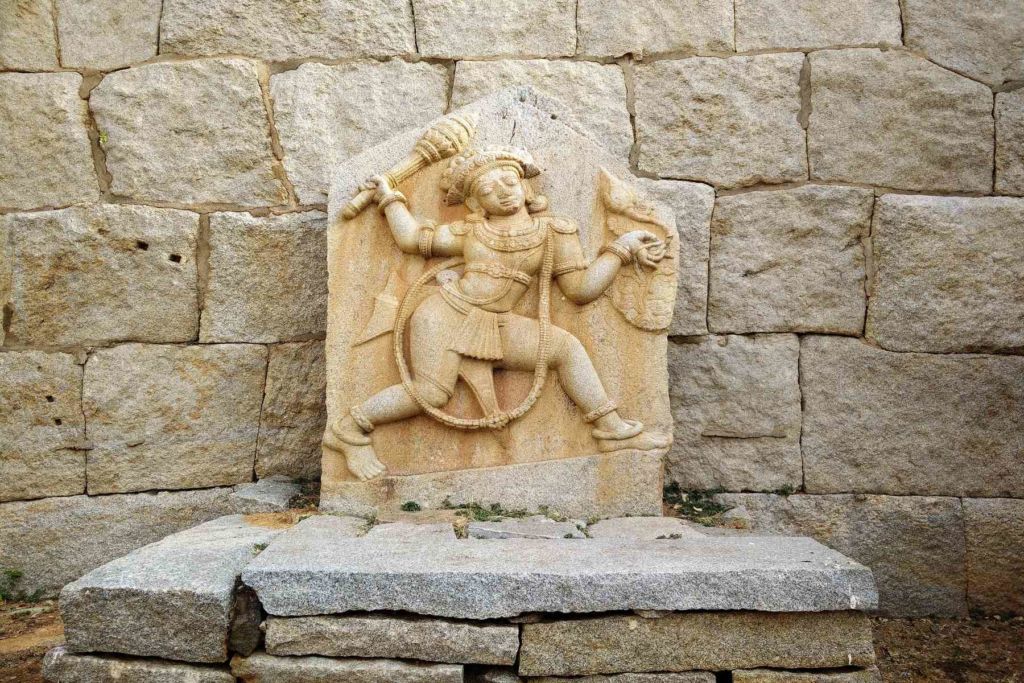
Talarighatta Gate:
The Talarighatta gate is a 2 storeyed gateway to enter the city of Hampi from Kamalapura. Going by the name, this gate acted as the Toll gate. Although partly damaged, this gate still stands tall. Permission to climb the Talarighatta gate stands revoked now. This is great place to take a picture with the Talarighatta gate in the backdrop. I have a picture of myself running past it for the past 4 years as a part of my GHR Hampi runcation!
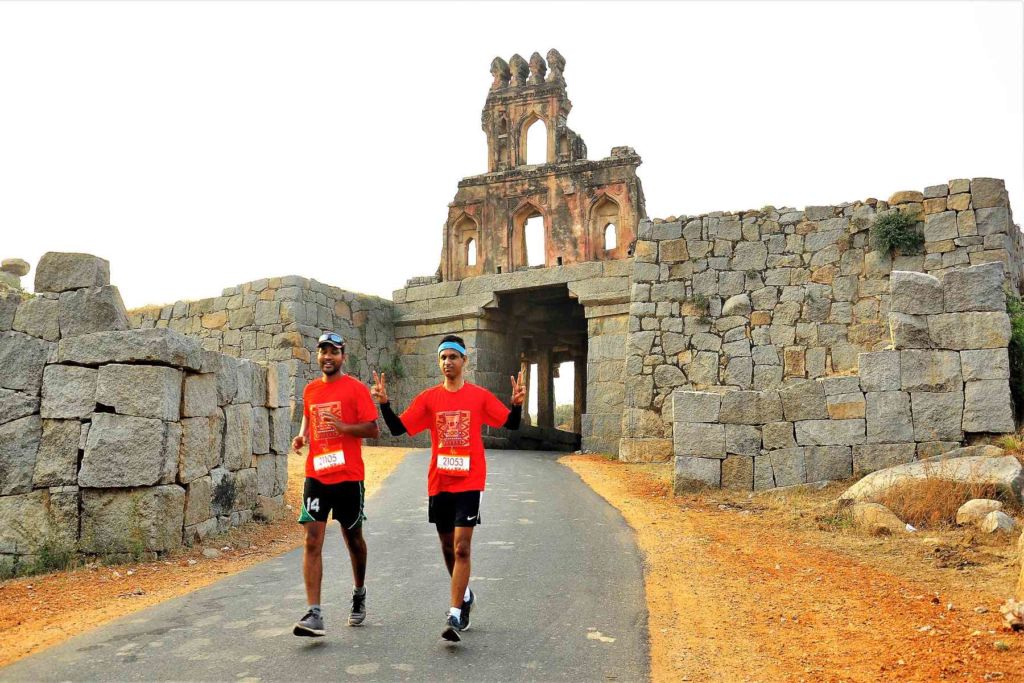
Vijaya Vittala Temple:
Built during the 15th century, this temple’s gopuram is sadly in ruins. This temple dedicated to Vittala – an avatar of Lord Vishnu has impressive carvings and extremely popular for the ‘Stone Chariot’ and the musical pillars. ASI is restoring portions of the temple, some of them cannot be visited.
ASI recently began to protect the Stone Chariot as many travelers invariably touch or lean against it. It is said that the wheels of the chariot used to rotate until they were cemented to avoid damage. The presence of elephants in front of the temple is a recent thing. They were originally horses which are still visible behind the elephant sculptures.
There are interesting carvings and sculptures which tell a story around the temple. It is a recommend to visit this temple with a guide who can explain many interesting facets. Don’t miss the lonely frangipani tree which serves as an interesting picture!

One must either walk or avail the services of a buggy from the Vittala complex stop located close to Gejjala Mantapa. As you pass by the Gejjala Mantapa you will see the erect stone pillars of the Vittala bazaar. In addition to which you will also pass by the pillars depicting horses of the Kudure Gombe Mantapa. There is also a large kalyani (pond), depending upon the time of the year it might have some water. One can also reach this temple along the river side, however the path is uneven and rocky.
Purandaradasa Mantapa:
The Purandaradasa Mantapa is located on the banks of the Tungabhadra River and not far away from the Vittala temple. The great saint Purandaradasa composed thousands of classical compositions here, not to mention many of his compositions are even sung today. There is a small statue of Purandaradasa with his tambura (musical instrument) in this pavilion. One must remove their footwear before entering the pavilion area.
Purandaradasa spent his last years in Hampi and sang in the court of Krishnadevaraya. He stayed in the mantapa known as Purandaradasa Mantapa today. Purandaradasa died in 1565 and as per the legend he altogether composed 475,000 songs. This is a nice place to relax and spend sometime with the waters of the Tungabhadra river that passes by.

Kings Balance:
Appearing like an archway not far from the Vittala temple is the Kings Balance. The 15 feet pillars of the Kings Balance support a heavy stone beam 12 feet long. There are 3 hoops on the underside of the stone beam to hang the balance. On special occasions like Coronation, Dasara etc … the King used to weigh himself with gold, jewels and gems and give them away as charity to the temple priests!
As per the legend, the King would feed on rich food a few days before the occasion. The reason being… the more the King weighed, the more would be the charity in the form of jewels to the priests! Quite fascinating isn’t it? I have run past this balance many a times and undoubtedly a towering sight!
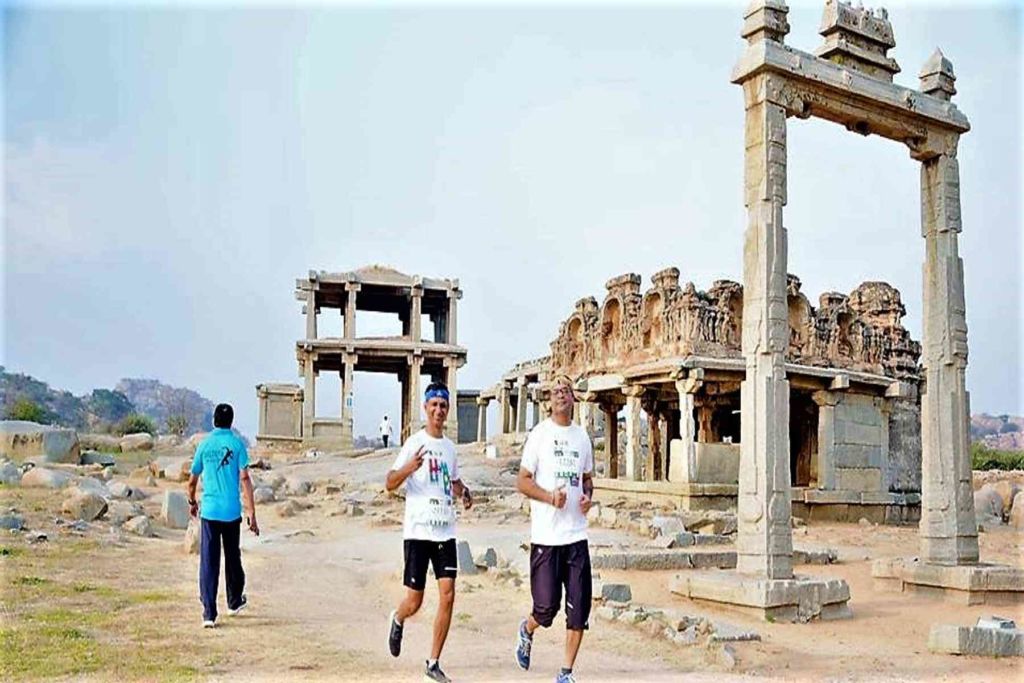
Kishkinda Kingdom:
The Kishkinda Kingdom has a reference to the epic Ramayana and known as monkey or vanara kingdom. Yes, this is the place where events such as Hanuman meeting Lord Rama and Lakshman, killing of Bali and crowning of Sugreev happened. This is located on the other side of the Tungabhadra River.
Pampa Sarovar:
Located on the other side of the Tungabhadra river, this lake is beautiful when the lotus flowers bloom. This might depend on the season of the year as I didn’t see any when I traveled there. As mentioned earlier, this place has a strong mythological connect and considered sacred for the Hindus.
In addition to the legendary story of Pampa marring Lord Shiva, this place has a reference to Shabri from the epic Ramayana. Shabri’s guru sage Matanga had told her that Lord Rama and Lakshman would visit her someday. In anticipation of their arrival, Shabri used to taste and select the sweetest of berries on daily basis.
After many years, Lord Rama and Lakshman do arrive and meet Shabri at her cottage here and eat the berries chosen by her. Shabri then tells Lord Rama to take the help of Sugreev in his quest to finding Sita. This is particularly a significant event leading to the Kishkinda Kanda chapter in the epic Ramayana.
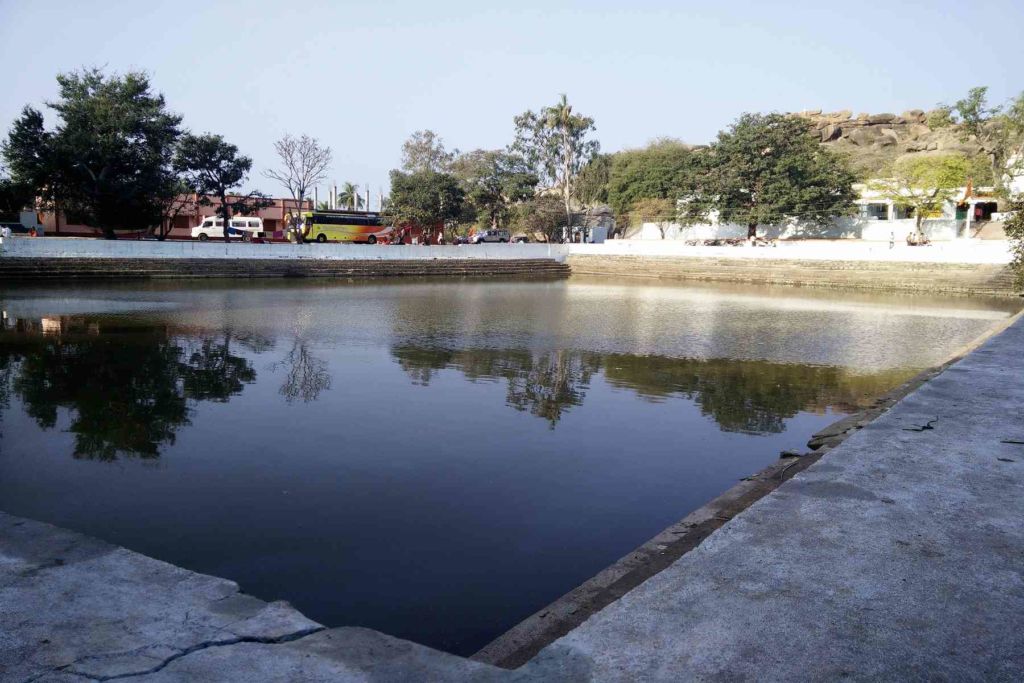
Rishyamukha Hill:
Rishyamukha Hill is located near Anjanadri Hill and Pampa Sarovar on the other side of the Tungabhadra river. This hill has boulders placed one over another or supporting each other. The path to Rishyamukha Hill is a stony one and wearing shoes is certainly a recommend.
This place is worth a visit if you are interested in mythology and mentioned in the epic Ramayana. Read the mythological connect below to understand the background and what is it famous for.
Mythological connect:
As per the legend, Sage Matanga resided in the Rishyamukha Hill. Dundubhi a demon in the form of a bull challenged the monkey king ‘Vali’ for a fight. After a long duel Vali prevailed and flung the corpse many miles away, the blood of which fell on Sage Matanga performing a yagna.
The visibly upset sage cursed whoever was responsible for this would not be able to step onto the Rishyamukha Hill. If one did so, the head would explode and live no more.
Vali’s brother Sugreev took advantage this and hid in this hill knowing his brother could never enter it!
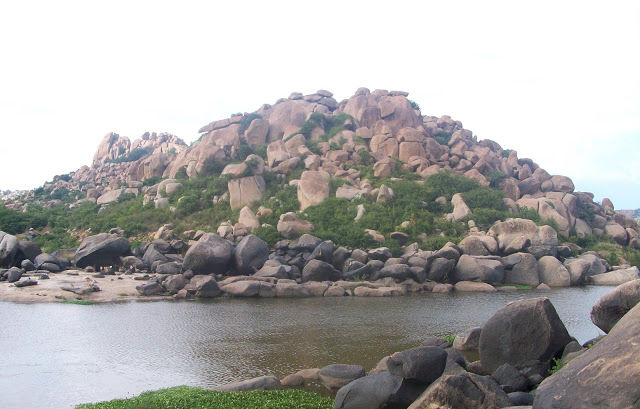
Malyavanta Raghunatha Temple:
As per the legend, Lord Rama and Lakshman took shelter under the Malyavanta hill during the rainy season before proceeding to wage a war against demon king Ravana. We discovered this temple by chance as we noticed an arch leading to the temple built around a huge boulder. The boulder has images of Lord Rama, Lakshman, Sita and Hanuman carved on it.
Priests here surprisingly recite the Valmiki Ramayana 24×7, 365 days in a year and relieved every 3-4 hours. Not to mention, this has been going on for a decade now! A map hung on this wall depicts the path that Lord Rama took from the north to south before proceeding further ahead.
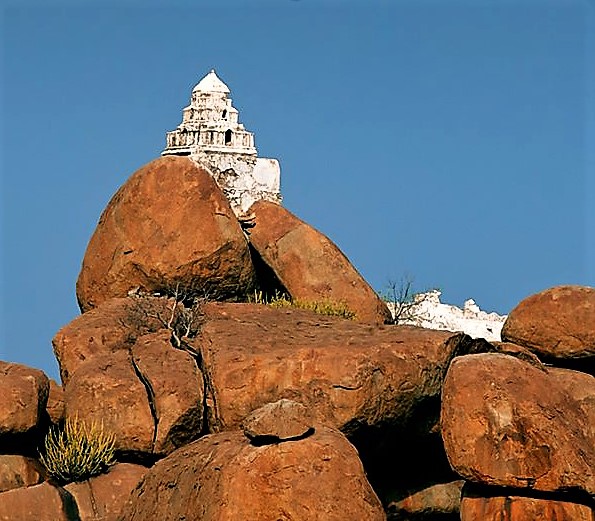
Anjanadri Hill:
As far as the epic Ramayana goes, the north of India is famous for Ayodhya being the birthplace of Lord Rama. Likewise Hampi in the south of India is popular as its the birthplace of his devotee ‘Hanuman’.
Hanuman was born on Anjanadri Hill and there is a small temple on the top. The temple has a stone floating on water and supposed to one of the rocks used to cross the ocean across to Srilanka. Outside the temple, one can see many people who have tied threads to a tree.
The foothills of the hill have transformed over the years with many shops sprouting up and selling religious items. Anjanadri Hill is a great place for experiencing the sunset and hence a must visit. I recommend you to either avail private transport or drive down to this place as the ferry closes by 5 pm.
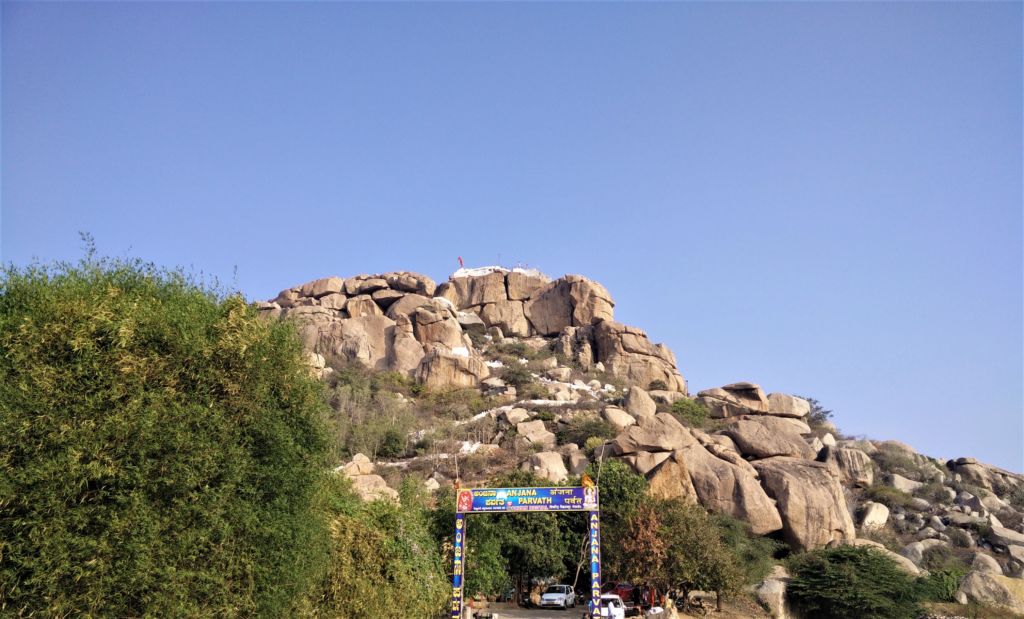
Hippie Island:
On the other side of the Tungabhadra river lies the Hippie island frequented by foreigners and youngsters. This stretch gives a completely different view of the city of Hampi with music, hookah and ale readily available! The best way to reach this place is to take a boat or coracle ride to the other side. The coracle and boat ride is operational until 5 pm only, hence one needs to plan accordingly. It might be worth it to stay for a night in one of the cottages or rooms on the other side. You will need to book the room in advance as they are normally on high demand!
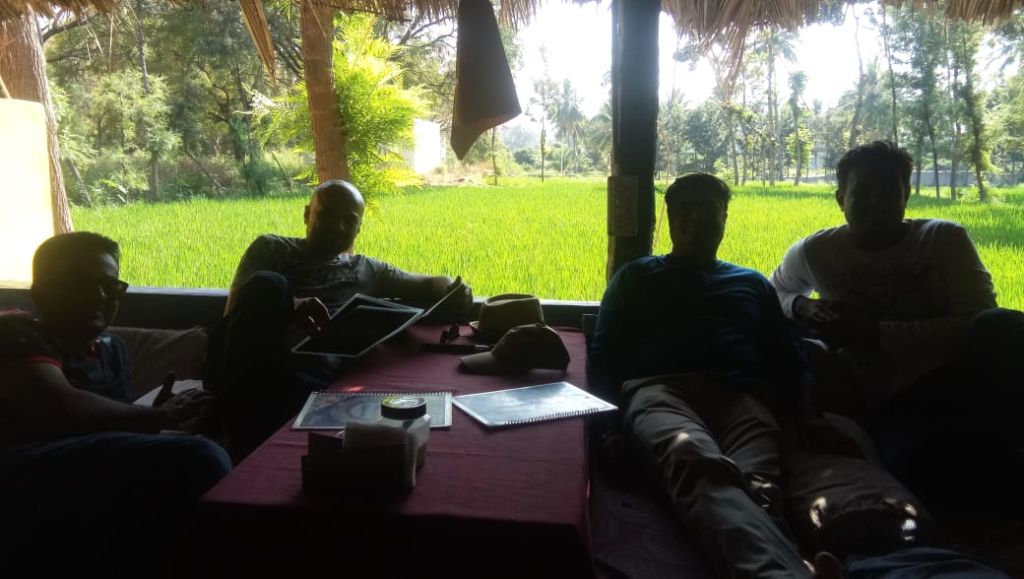
In conclusion, Hampi is a must visit and I can ensure you wont be disappointed! Yes there is a lot to see in Hampi, therefore its better to invest at least 3-4 days or even a week!
If you are wondering whether I would be visiting Hampi next year, its anyone’s guess! See you there next time 🙂
How does one get to Hampi?
From Bengaluru one can get to Hampi by bus, train or by car. However the bus or train would stop by the city of Hospet from where you will need to catch a bus or taxi to reach Hampi. Therefore driving down to Hampi is a better option. A drive to Hampi from Bengaluru takes about 5-6 hours including breaks. The driving times have significantly come down after the 4 lane highway has been operational.
As you pass by Chitradurga to and from Hampi, you might want to cover the Chitradurga fort. Likewise, if you have time, you can take a deviation and visit the historic city of Sira near Chitradurga.
What are the places close to Hampi?
There are many places of historical importance with sites having UNESCO status at driving distances from Hampi:
- Badami: Rock Cut Cave temples (UNESCO heritage) of Badami are famous. Built by the Chalukya dynasty in the 6th century, Badami is about 3 and half hours drive from Hampi.
- Pattadakal: The numerous differently styled temples of Pattadakal (UNESCO heritage) is an architects delight. Built by the Chalukyas in the 7th and 8th century, Pattatakal is about 3 and half hours drive from Hampi.
- Aihole: Like Pattadakal, the ancient temples of Aihole are also popular. Aihole was the capital of the Chalukya dynasty and 3 hours drive from Hampi.
- Bijapur: Unlike the above, Bijapur doesn’t have any site with an UNESCO status. However it is famous for the Gol Gumbaz and other Bahamani structures dating back to the 17th century. The driving time from Hampi to Bijapur (Vijayapura) is about 4 and half hours.
- Hubli and Dharwad: The twin cities Hubli and Dharwad are about 4 and half hours drive away from Hampi. Hubli is famous for its art and literature from the 12th century and Dharwad of course for its Babusingh Thakur Dharwad peda!
For more such historical experiences, check out the historical places to visit in India. And in case culture is of interest, check out the cultural places representing the history of ancient India.
In case you are keen on traveling to Hampi, Write to us and we can help craft an experiential travel itinerary for you.
India is not just about history. In fact, there are many more facets to this ancient land – culture, spirituality, mystery, nature, wildlife and so on. Check out the holiday and tour packages representing the different facets of India travel.

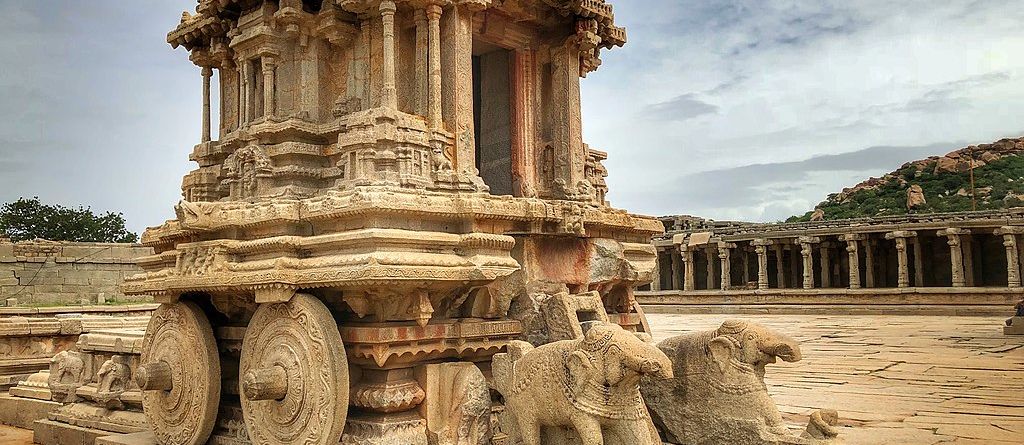
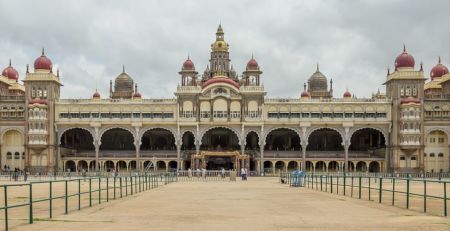
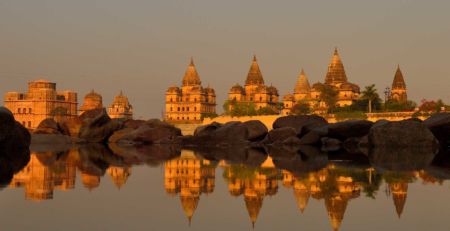


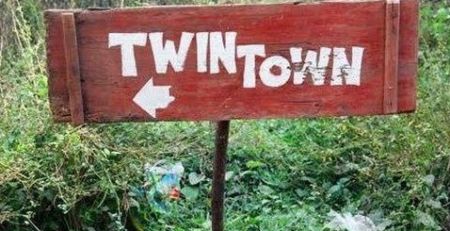
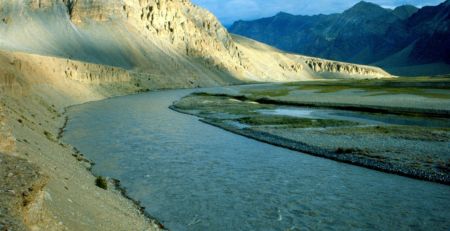
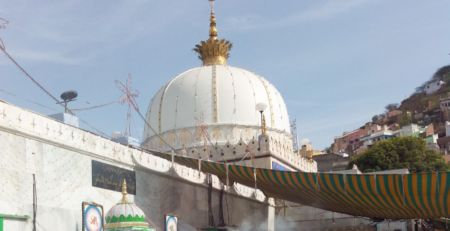
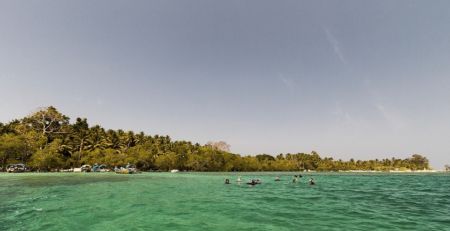
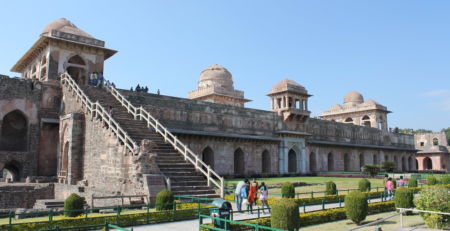

Comments (5)
Kishen has described almost all parts of the Hampi. I heard Kishen that, he felt like we missed something to cover. This is what is Hampi. It’s a kind of ocean, how much ever we explore there, we still miss something.
Thanks Kishen for giving us a detailed blog about monuments of Hampi. Keep exploring more and more every year.
Thanks Srikanth. After all Hampi was not built overnight, it will take time to cover it. Just when you think you have covered it all, you will realize there is much more that you missed out on!
That was one awesome read on Hampi. Thank you for putting it forth for us.
Thanks Sharath! Glad to know you liked it.
Greatly described !